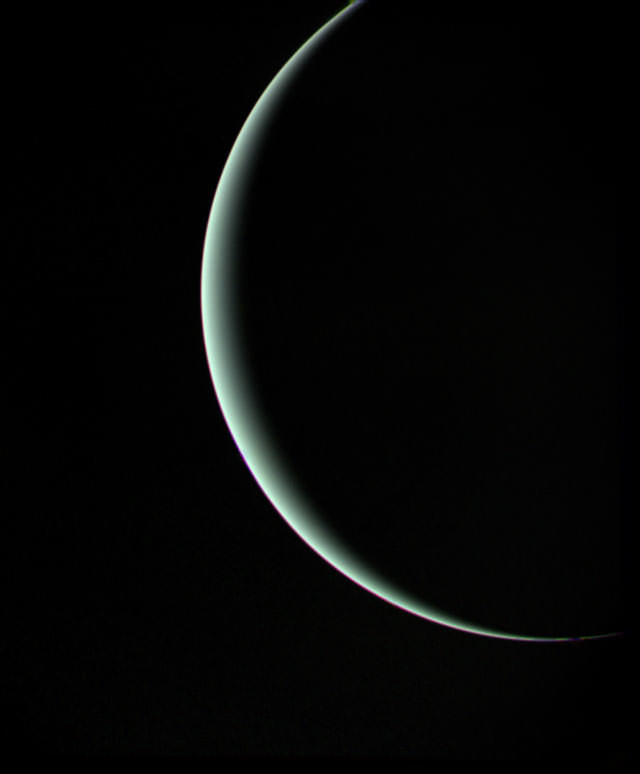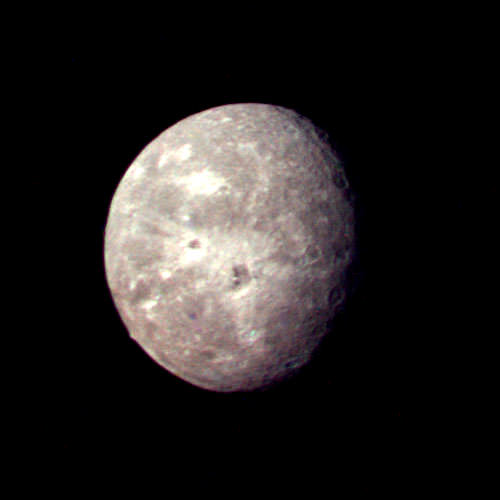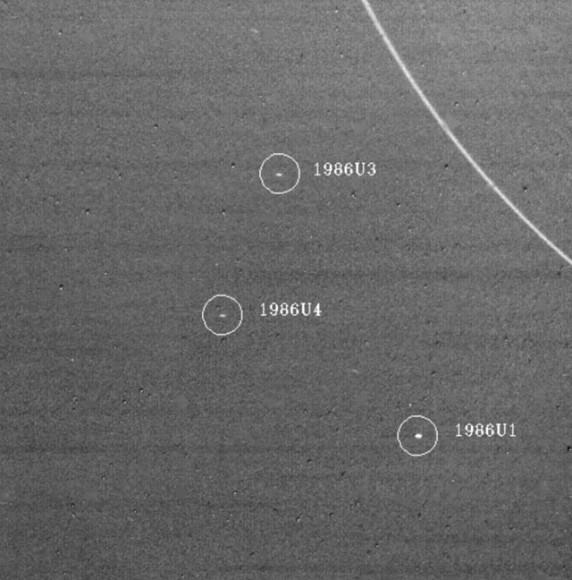Image of Uranus’ crescent taken by a departing Voyager 2 on January 25, 1986 (NASA/JPL)
27 years ago today, January 24, 1986, NASA’s Voyager 2 spacecraft sped past Uranus, becoming simultaneously the first and last spacecraft to visit the blue-tinged gas giant, third largest planet in the Solar System.
The image above shows the crescent-lit Uranus as seen by Voyager 2 from a distance of about 965,000 km (600,000 miles.) At the time the spacecraft had already passed Uranus and was looking back at the planet on its way outwards toward Neptune.
Although composed primarily of hydrogen and helium, trace amounts of methane in Uranus’ uppermost atmosphere absorb most of the red wavelengths of light, making the planet appear a pale blue color.
Image of the 1,500-km-wide Oberon acquired by Voyager 2 on Jan. 24, 1986 (NASA/JPL)
The second of NASA’s twin space explorers (although it launched first) Voyager 2 came within 81,800 kilometers (50,600 miles) of Uranus on January 24, 1986, gathering images of the sideways planet, its rings and several of its moons. Voyager 2 also discovered the presence of a magnetic field around Uranus, as well as 10 new small moons.
Three moons discovered by Voyager 2 in 1986 (NASA/JPL)
Data gathered by Voyager 2 revealed that Uranus’ rate of rotation is 17 hours, 14 minutes.
At the time of this writing, Voyager 2 is 15,184,370,900 km from Earth and steadily moving toward the edge of the Solar System at a speed of about 3.3 AU per year. At that distance, signals from Voyager take just over 14 hours and 4 minutes to reach us.
See images from Voyager 2’s visit of Uranus here, and check out a video of the August 20, 1977 launch below along with more images from the historic Voyager mission’s “Grand Tour” of the outer Solar System.




I was in 6th grade and remember reading about it in the paper.
I remember being impatient to see these photos in Owl magazine.
I didn’t even exist in 1986! It’s sad to think, even if they launched tomorrow, we’d probably not see new images of Uranus till 2022? I’ll be an old fossil by then!
Hey… careful with the “old fossil” comments. Some of us here are virtually Precambrian by your standards. 😉
I believe that’s my lawn you’re standing on. 🙂
Those wonderful, surprising moons with the great names. I think there was a PBS Nova at the time featuring a lot of Gene Shoemaker explaining the theories of formation and structure. This was a big deal at the time, we’re used to finding all kinds of new stuff these days, but those were new worlds we only had vague imagery of until Vger2. I grew up with a lot of fuzzy blobs and dim, unresolved points of light. Thanks for the nostalgia, Jason!
It went to Ur anus hehe. http://www.ficksitall.blogspot.com
too bad voyager didn’t probe uranus more thoroughly. it may have found kling-ons
And you are what? 12 years old? And that poor attempt at a joke is way older than you are. Jeez,,,,
lighten up, pops!
Great images. To think these were made 27 years ago, quite a major feat. I’m following these 2 really closely. Hope they break to interstellar space soon.
Back then our local public access cable station would broadcast
the NASA channel in the evenings and off hours. I remember sitting in my living
room watching live full screen pictures coming video from Voyager as it approached
Neptune in 1989.
So amazing being able to watch “live pictures” from the edge
of our solar system sitting on my couch back then.
PBS did a lot during the encounter. This was the first Voyager encounter in the cable-TV age, so a few channels (mostly PEG or “community access” channels) were covering the fly-by. Mostly we were just showing JPL computer displays, but it was a glimpse of a new era in communications and public access.
I remember Billions and Biliions by Carl Sagan.
What an amazing accomplishment by only 2 little probes with no more camera power than your average cell phone uses these days. Imagine what new discoveries we could make if we sent new probes out to the gas giants today !
Too bad human kind is too busy fighting each other, than expanding our knowledge of our beautiful universe.
Curious that the Cloud Planet is “hotter at its equator than at its poles”. Mysterious source of internal heat? Also intriguing: possible retrograde rotation. What disturbance in time, laid a world low?
If the ice giant could only speak through covering veils cast,
What turbulent events might surface from the hidden past?
What wonders surreal lie below the bands of rapid storm?
What secrets lay concealed, under decks of mist unborn?
Sun sheds its cold light, on the fallen Giant in realm of ice.
In its layered depth of gas, what source of heat does entice?
Hazy orb of aquamarine, with dark, hefty-block Rings encircled,
Uranus rolls along orbit, the revolving moons shadow wreathed.